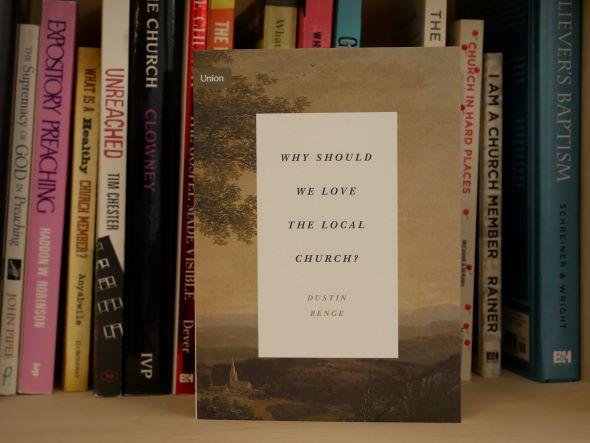Let’s Read: Why Should We Love the Local Church—You’re Beautiful

Let’s Read: Why Should We Love the Local Church—You’re Beautiful
By Davy Ellison
You’re Beautiful
My Duke of Edinburgh Gold Expedition took place in the Lake District. This meant that we all had to bundle into the school minibus just outside Belfast, catch a sailing across to Scotland and drive down to where our hike would begin. Apart from the dodgy school minibus we had one other constant companion: James Blunt. His album Back to Bedlam was stuck in the CD player and the radio did not work. As a result, I think I listened to the full album about 20 times—ten times nonstop on the way there and the same again on the way back! The melody of You’re Beautiful— arguably Blunt’s most famous song—will forever be ingrained in my memory. As cheesy and irritating as this song is, its tagline should be sung to the church: You’re Beautiful.
Three Reasons Why
The church is beautiful is Benge’s assertion in the first five chapters of Why Should we Love the Local Church? His argument can be summarised in three categories.
First, argues Benge, the church is beautiful because of the cross. He writes: “The church is beautiful because the lens through which Christ regards her is his cross . . . Ultimately, the cross of the Lord Jesus Christ makes her beautiful. It is his sacrificial, substitutionary, sinless blood that washes her garments as white as snow” (p. 18). As Scripture elsewhere elucidates, our salvation has transformed us into the bride of Christ. In and through Jesus our sin has been dealt with and we now robe ourselves with his righteousness. Such beautifying of the bride is described vividly in Ezekiel 16, although sadly that chapter also details the lack of faithfulness exercised by this bride. The cross of Christ, however, ensures that our faithlessness is forgivable when confessed. Thus, ensuring our beauty. Benge adds:
The church is uniquely those who have been called out of sinful darkness by God the Father through salvation in Jesus Christ, are now sealed by the Holy Spirit, and now belong to the Lord. The church thus finds her origin, beauty, and perfection in the triune God. (p. 23)
The church is beautiful because through the cross her ugly scars of sin are covered by the blood of Jesus.
Second, Benge discusses the way in which the church is beautiful because it is God’s home. The Bible is clear that “God resides explicitly in a distinctive and familial way among his people” (p. 21). It is in this way that we can assert that God makes his home in the church. The ragtag bunch of people who spill into a building moments before the service commences—or, more frequently, after it has begun—are a glorious home. If there was a divine PropertyPal they would top the most viewed properties. They are a Price On Asking kind of property, that is to say beyond our price range. In more biblical language, the church is the temple of God (1 Cor. 3:16–17; 6:19–20). If God dwells in us individually, then as we gather corporately God dwells with us together. In a wonderfully lavish paragraph Benge encourages us with these words:
Our one hope is the constant abiding presence of God—forever—which assures the church that God has not forsaken, nor will he ever forsake, his home. He will never love the church any less than he always has. He will never divorce the church. He will never go searching for a more attractive family. He will never move out or move away. The cascade of his love to her will never dissolve, for it runs from eternity past to eternity future . . . He doesn’t regret pursuing us with his everlasting love. God delights to make the church his household and makes her beautiful by his presence among her. (p. 24)
Third, explains Benge, the church is beautiful because of her relationship with each person of the Trinity. Initially, “As our Father, God grants the church an intimacy and relationship with him that is all her own” (p. 27). We are then reminded that “The church doesn’t belong to pastors or church members; the church belongs to Christ, and he is its sovereign head. The church is intimately united to Christ as her Saviour and head” (p. 32). Finally, we are encouraged that “The Holy Spirit is sufficient to equip and empower you to discharge every aspect of the turning-the-world-upside-down ministry to which Jesus has called his church” (p. 34). The church is beautiful because of the distinct, intimate and energising relationship she enjoys with each member of the Trinity.
The Ultimate Source of Beauty
As the Creator and Sustainer of all we see and all we do not see, God is the ultimate source of everything. He is therefore the ultimate source of beauty. The eclectic mix of individuals that constitute the church—both local and universal—find their beauty only in their relationship to God. But instead of weakening the assertion that the church is beautiful, this reality only strengthens it further. As Benge summarises: “The church is beautiful because God is beautiful” (p.19). Perhaps on Sunday we will stride into church humming, You’re beautiful, You’re beautiful, You’re beautiful, it’s true.
Questions for Reflection
- Are there particular things you could do on a Sunday morning that would prepare you to see your local church as beautiful despite all its faults?
- If you are a Christian you are part of the universal church. Do you see yourself as beautiful in the way that has been described above? Why or why not?
- Pray now for your local church, giving thanks to God that he has made her so beautiful.





